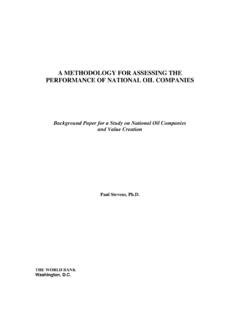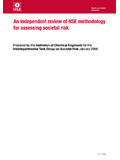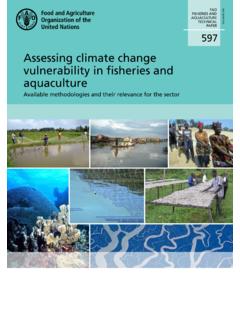Transcription of S MEASUREMENT SYSTEM (SMS) METHODOLOGY
1 COMPREHENSIVE SAFETY ANALYSIS 2010. SAFETY MEASUREMENT SYSTEM (SMS) METHODOLOGY . Version August 2010. Prepared for: Prepared by: Federal Motor Carrier Safety Administration John A. Volpe National Transportation 1200 New Jersey Avenue, SE Systems Center Washington, DC 20590 55 Broadway Cambridge, MA 02142. Preface This report documents the Safety MEASUREMENT SYSTEM (SMS) METHODOLOGY developed to support the Comprehensive Safety Analysis 2010 (CSA 2010) Initiative for the Federal Motor Carrier Safety Administration (FMCSA). The SMS is one of the major tools for measuring the safety of individual motor carriers and Commercial Motor Vehicle (CMV). drivers. Such measures help identify and monitor safety problems as part of the CSA. 2010 safety improvement process. Many of the concepts used to construct the SMS originated from the SafeStat MEASUREMENT SYSTEM . SafeStat was developed at the Department of Transportation s John A.
2 Volpe National Transportation Systems Center (the Volpe Center) in Cambridge, MA, under a project plan agreement with the Federal Highway Administration s Office of Motor Carriers, FMCSA s predecessor. It was designed and tested under the Federal/State Performance & Registration Information Systems Management (PRISM). program in the mid 1990s. Since then, SafeStat has been implemented nationally to prioritize motor carriers for on-site Compliance Reviews (CRs). SafeStat output has been made available to the public via the Internet on the Analysis & Information (A&I). website at The SMS design builds on the lessons learned from developing and implementing SafeStat for CR prioritization. However, the SMS also incorporates new CSA 2010. requirements for identifying specific types of unsafe behaviors that the entities exhibit. A. more specialized set of interventions will now address these unsafe behaviors and the SYSTEM will also expand the use of on-road safety violation data.
3 In January 2008, FMCSA started an Operational Model (OM) Test of the CSA 2010 Initiative, which includes using the SMS to identify and monitor unsafe carrier and CMV driver behavior in nine states. Version of the METHODOLOGY incorporates feedback from the OM Test and was implemented as part of the CSA 2010 Data Preview in August 2010 which provided SMS results to carriers nationally. Future SMS development will be part of a continuous improvement process based on results and feedback. The Volpe Center Technical Project Manager for developing the SMS is David Madsen of the SYSTEM MEASUREMENT and Analysis Division of the Center for Safety Management Systems. Eran Segev, also of the SYSTEM MEASUREMENT and Analysis Division, headed the analysis leading to the SMS design and METHODOLOGY . Further technical support was provided by the following Volpe Center staff: Lee Biernbaum, Kevin Gay, Gustaf Lawson, Richard (Kha) Nguyen, Amy Olanyk, Jonathan Pearlman and Scott Smith.
4 August 2010 i Table of Contents List of Figures .. iii List of Tables .. iii Glossary .. v Glossary .. v 1. Introduction .. 1-1. 2. Design of the SMS .. 2-1. Description of BASICs and Crash Indicator .. 2-1. Data Sources .. 2-2. Carrier BASICs Rankings in 2-3. SMS Design Features .. 2-4. Violation Severity .. 2-4. Crash Severity .. 2-4. Time Weights .. 2-4. Normalization .. 2-4. 2-5. Safety Event Groups .. 2-5. Data 2-5. Percentile Rank .. 2-5. Differences Between SafeStat and the SMS .. 2-5. 3. CSMS METHODOLOGY .. 3-1. Unsafe Driving BASIC Assessment .. 3-1. Calculation of BASIC Measure .. 3-1. Calculation of BASIC Percentile 3-3. Fatigued Driving (HOS) BASIC Assessment .. 3-4. Calculation of BASIC Measure .. 3-5. Calculation of BASIC Percentile 3-6. Driver Fitness BASIC Assessment .. 3-6. Calculation of BASIC Measure .. 3-7. Calculation of BASIC Percentile 3-8. Controlled Substances/Alcohol BASIC.
5 3-9. Calculation of BASIC Measure .. 3-9. Calculation of BASIC percentile rank .. 3-10. Vehicle Maintenance BASIC Assessment .. 3-11. Calculation of BASIC Measure .. 3-11. Calculation of BASIC Percentile 3-12. Cargo-Related BASIC 3-13. Calculation of BASIC Measure .. 3-13. August 2010 ii Calculation of BASIC Percentile 3-14. Crash Indicator Assessment .. 3-15. Calculation of Crash Indicator Measure .. 3-15. Calculation of Crash Indicator Percentile 3-18. 4. DSMS METHODOLOGY .. 4-1. Unsafe Driving BASIC and Controlled Substances/Alcohol BASIC Assessment 4- 1. Calculation of BASIC Measure .. 4-2. Calculation of BASIC Percentile 4-2. Fatigued Driving (HOS) BASIC and Driver Fitness BASIC Assessment .. 4-3. Calculation of BASIC Measure .. 4-3. Calculation of BASIC Percentile 4-4. Vehicle Maintenance BASIC and Cargo-Related BASIC Assessment .. 4-5. Calculation of BASIC Measure .. 4-5. Calculation of BASIC Percentile 4-6.
6 Crash Indicator Assessment .. 4-7. Calculation of Crash Indicator Measure .. 4-7. Calculation of Crash Indicator Percentile 4-8. 5. Sample SMS Output .. 5-1. 6. SMS Report Summary/Next Steps .. 6-4. Appendix A ..A-1. Appendix B .. B-1. List of Figures Figure 1-1. CSA 2010 Operational Model .. 1-1. Figure 2-2-1. BASICs Ranking Process .. 2-3. Figure 5-1. CSMS 5-2. Figure 5-2. DSMS Screenshot .. 5-3. List of Tables Table 3-1. VMT per PU for Combo 3-3. Table 3-2. VMT per Average PU for Straight Segment .. 3-3. Table 3-3. Safety Event Group Categories for Unsafe Driving BASIC .. 3-4. Table 3-4. Safety Event Group Categories for the Fatigued Driving (HOS) BASIC .. 3-6. Table 3-5. Safety Event Group Categories for the Driver Fitness BASIC .. 3-8. August 2010 iii Table 3-6. Safety Event Group Categories for Controlled Substances/Alcohol BASIC .. 3- 10. Table 3-7. Safety Event Group Categories for the Vehicle Maintenance BASIC.
7 3-12. Table 3-8. Safety Event Group Categories for the Cargo-Related 3-15. Table 3-9. Crash Severity Weights for Crash Indicator .. 3-16. Table 3-10. VMT per PU for Combo 3-17. Table 3-11. VMT per Average PU for Straight Segment .. 3-18. Table 3-12. Safety Event Group Categories for Crash Indicator .. 3-18. Table 4-1. Safety Event Group Categories for Fatigued Driving (HOS) and Driver Fitness BASICs .. 4-5. Table 4-2. Safety Event Group Categories for Vehicle Maintenance and Cargo-Related BASICs .. 4-7. Table 4-3. Crash Severity Weights for Crash Indicator .. 4-8. August 2010 iv Glossary BASIC Behavior Analysis and Safety Improvement Categories CMV Commercial Motor Vehicle CR Compliance Review CRWG Compliance Review Work Group CSA 2010 Comprehensive Safety Analysis 2010. CSMS Carrier Safety MEASUREMENT SYSTEM DIR Driver Information Resource DSMS Driver Safety MEASUREMENT SYSTEM FMCSA Federal Motor Carrier Safety Administration FMCSR Federal Motor Carrier Safety Regulations HAZMAT Hazardous Materials HMR Hazardous Materials Regulations HOS Hours-Of-Service LTCCS Large Truck Crash Causation Study MCMIS Motor Carrier Management Information SYSTEM MCSAP Motor Carrier Safety Assistance Program NGA National Governors Association NTSB National Transportation Safety Board OOS Out-Of-Service OM Operational Model PU Power Unit PRISM Performance and Registration Information Systems Management SafeStat Motor Carrier Safety Status MEASUREMENT SYSTEM SEA Safety Evaluation Area SFD Safety Fitness Determination SMS Safety MEASUREMENT SYSTEM USDOT Department of Transportation VSAS Violation Severity Assessment Study VMT Vehicle Miles Travelled August 2010 v 1.
8 Introduction The Federal Motor Carrier Safety Administration (FMCSA) is developing a new OM. through its Comprehensive Safety Analysis 2010 (CSA 2010) Initiative. The goal of CSA 2010 is to develop and implement more effective and efficient ways for FMCSA, its state partners, and the trucking industry to reduce CMV crashes, fatalities, and injuries. CSA 2010 will help FMCSA and its state partners to impact the safety behavior of more carriers and drivers, use continually improving data to better identify high-risk carriers and drivers, and apply a wider range of interventions to reduce high-risk As part of this effort, FMCSA has identified the attributes of a model for safety oversight that it considers ideal: flexibility, efficiency, effectiveness, innovation, and equity. The CSA 2010 OM, shown below, features continuous monitoring and tracking of entities . safety performance. Entities may be either carriers or drivers.
9 All entities found with problematic safety behavior will be subject to the intervention process. Figure 1-1. CSA 2010 Operational Model 1. FMCSA CSA2010 website, August 2010 1-1. The Safety MEASUREMENT SYSTEM Within the CSA 2010 OM, the Safety MEASUREMENT SYSTEM (SMS) quantifies the on-road safety performance of individual entities to: Identify entities for interventions. The SMS will be a key component in determining the inclusion of entities with significant safety problems into the CSA 2010 intervention process. Determine the specific safety problems an entity exhibits. The SMS allows enforcement officers to identify the specific safety problems the SYSTEM highlights and to surgically address them through a tailored set of interventions. Monitor safety problems throughout the intervention process. The SMS will continuously monitor on-road performance to assess whether an entity s safety performance has improved enough for it to exit the intervention process, or if further intervention is warranted.
10 Support FMCSA s proposed Safety Fitness Determination (SFD) process. The SMS results can be an important factor in determining the safety fitness of entities. The SMS will identify the entities demonstrating the worst safety performance so they can be considered for an Unfit safety determination. Details on the proposed process will be available as for public comment as part of upcoming Notice of Proposed Rulemaking. In addition to supporting the CSA 2010 OM, the SMS results can provide other stakeholders with valuable safety information. The SMS results will be easily accessible via the Internet to encourage improvements in motor carrier safety. Findings from the SMS will allow the evaluated entities an assessment of their weaknesses in various safety areas. Thus, the SMS will empower carriers and other firms ( shippers, insurers). involved with the motor carrier industry to make safety-based business decisions.







